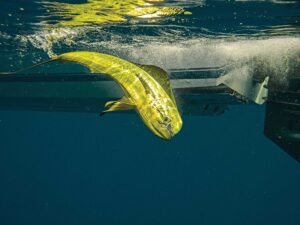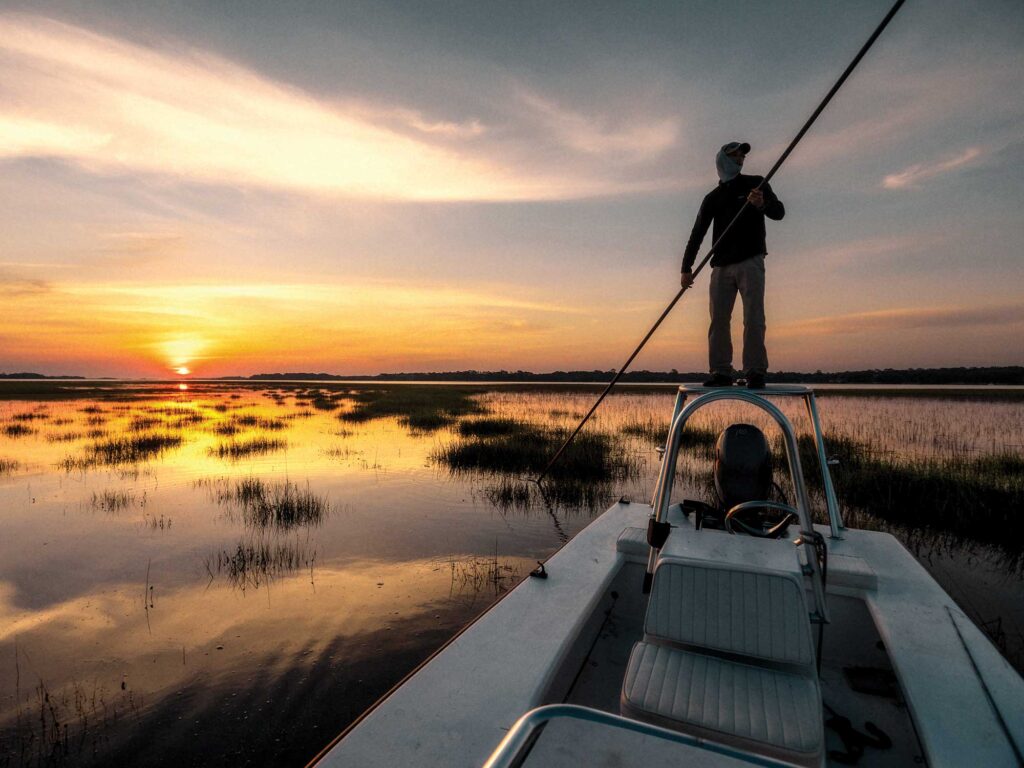
When it comes to South Carolina’s Lowcountry redfish, securing a big bite requires an understanding of an even bigger bight. Spell-checkers relax; that was not a typo. I’m referring to the South Atlantic Bight. Sometimes called the Georgia Bight, this dramatic coastal indention from roughly Cape Hatteras, North Carolina, to Cape Canaveral, Florida, brings a flavorful mix of challenge and opportunity.
The challenging part is simply a matter of water movement. Within the Georgia Bight, tides affect the coastline differently. Ports deeper within the bow of the bight see more dramatic tides, while areas north and south don’t see those same highs and lows. St. Simons and Jekyll islands, of Georgia, experience the most severe tidal ranges. Charleston isn’t far behind, with swings upward of 6 to 8 feet.
But there’s plenty of opportunity—a lot of redfish within the 15- to 23-inch slot, as well as a solid showing of hefty overslots that commonly reach 20-plus pounds. Known as bull reds, those big ones are another story for another day. Regardless of what you’re chasing, you must respect the bight’s impact on tides.
Local slot fishing centers on the shallow salt marshes; skinny passages skirt shallow bars and islands, while interior arteries pierce the Spartina vegetation. The opportunity is significant for hidden treasures, but the rules are rigid.
Capt. Ben Powers, of Reel Time Charters, says the region’s big tidal swings keep anglers on their toes—and not only for the obvious perils. As he points out, the significant depth changes mean fish don’t spend a lot of time in one spot.
“The fish aren’t staying in one area too long because when the water’s receding, they have to get out of there,” Powers says. “You’ll see a lot of fish on the move, and you have to stay on them without pressuring them too hard. Finding that balance is the key.”
To this point, Powers calls stealthy approaches and long casts essential. That’s why you tend to see long spinning outfits with braided main line tied to fluorocarbon leaders. That rigging stands up to the tough marsh-grass conditions.
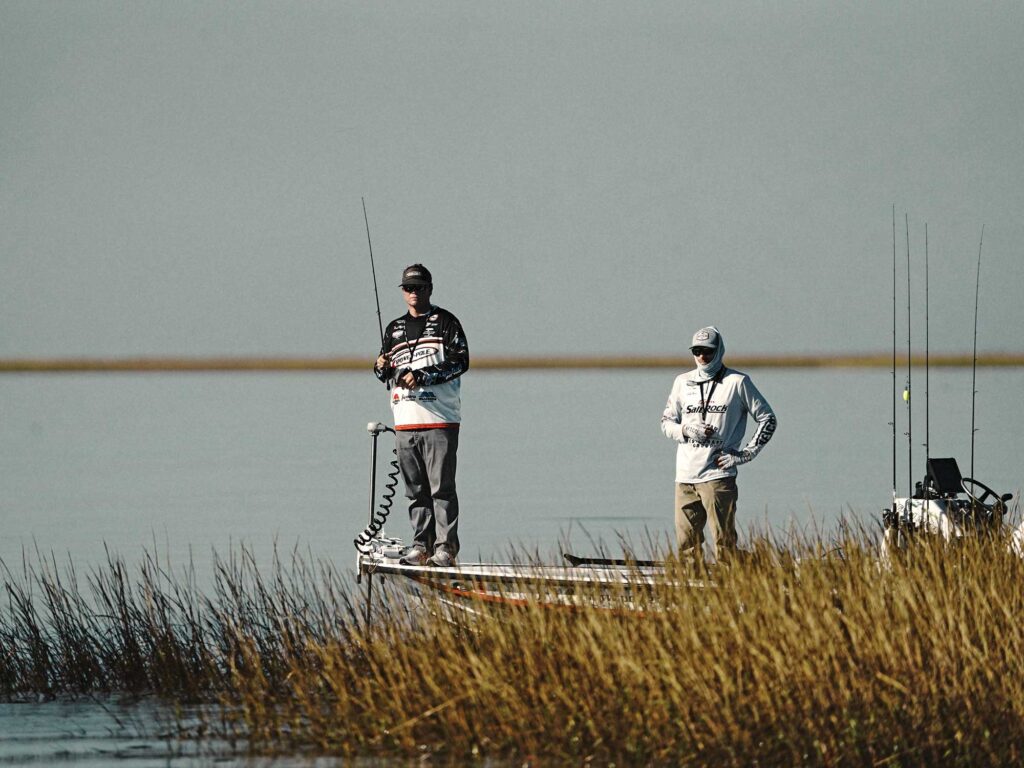
Mud Matters
Shallow-water navigation always merits caution, no matter where you’re fishing. In addition to oyster bars, leftover storm debris, floating wood and crab traps, the South Carolina coast guards its bounty with a brutally consistent and absolutely nonnegotiable sentry called “pluff mud.” A soft, claylike substance common to the Lowcountry, this fragrant blend (a comparable smell is rotting eggs) of decaying vegetation and wildlife mixed with sediment blankets the region.
With layers reaching double-digit depths, pluff mud will grip a wayward boat hull and hold tightly until rising water liberates the captive. No one is immune to angling mishaps, especially in waters governed by big tidal swings and unforgiving mud banks. Case in point, when last October’s Redfish Cup Championship brought a field of top-tier tournament anglers to Georgetown, South Carolina, four teams of these seasoned pros spent more time than they’d care to admit stuck on gooey mud banks.
But, don’t let the mud scare you. South Carolina’s Lowcountry is full of redfish, and those who learn to safely navigate its shallows will find plenty of willing targets. Before diving into the proven tactics, consider these pointers from experienced locals.
Understand the Variance
Consulting tide charts is on the syllabus in Fishing 101, but Capt. Jamie Hough, of Redfish Mafia Charters, stresses a comprehensive picture. Unless you plan on remaining within a couple miles of your launch site, knowing the tides throughout the area will help you avoid nasty surprises.
“First and foremost, people like to focus on high tide and low tide, but I think it’s more important to focus on how high and how low,” Hough says. “It’s more than checking that high tide is at 1:30 today. How high is it going to be? Is it going to be a 6-foot tide? Is it going to be 8 feet?”
As Hough notes, the tide swings intensify from Georgetown (Winyah Bay) south to the state’s border. For one thing, the water travels farther inward and builds greater momentum the deeper it moves into the coastal curve. Also, within this section of South Carolina, the ocean’s mostly unobstructed advance and withdrawal allows those tides to gain steam.
Compare that to the Waccamaw River, which overlaps the Intracoastal Waterway from the north. From the Waccamaw’s Winyah Bay outlet (Georgetown) northward, the ICW doesn’t see the Atlantic Ocean again until Little River Inlet, at the South Carolina-North Carolina border. Areas along the river could see tidal changes of just 2 feet or less. Bottom line: Know the flow before you go.
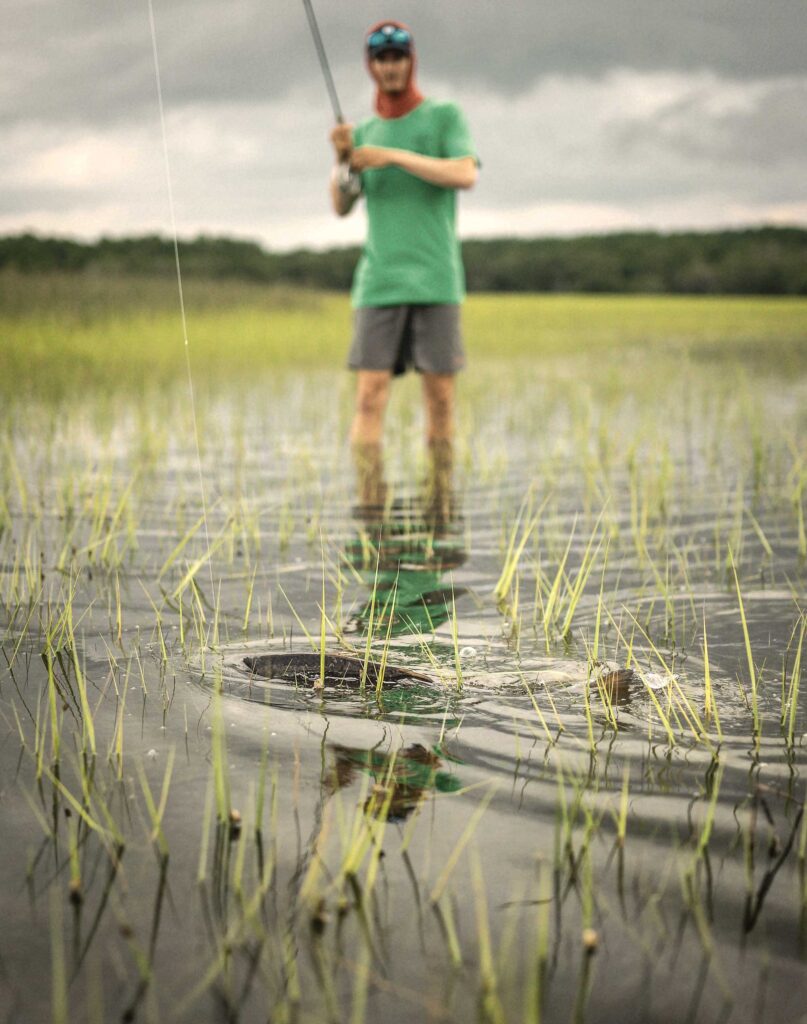
Recon Relief
While Hough says he favors a high tide, he also values the draining. As he explains, low water draws the curtains and offers strategic views of key travel lanes and obvious feeding areas, as well as the obstructions and high spots.
“At low tide, get the lay of the land,” Hough says. “Don’t just put the boat in the water and hope you don’t run into anything. The fish don’t live between the markers, so be careful.”
Hough is a big proponent of mechanical jack plates and stainless-steel props, especially in his potentially treacherous South Carolina waters. He buttresses that wisdom with some practical advice that will spare you an uncomfortable incident.
“A lot of times, people will go into a creek with their motor trimmed up and their jack plate up,” Hough says. “I advise people to go into these creeks with their motor down and the jack plate down, so when you start hitting bottom, you can trim the motor up and get out. If you already have the motor all the way up and you pile up on a mudflat when the tide is falling, you have no leeway.”
Know the Bottom
While pluff mud rules much of the South Carolina coastal marshes, Capt. Fred Rourk, of Sweet Tea Charters, notes that solid bottom—firm enough to wade-fish—exists. Nature is not random, so he suggests newcomers pay attention to the different types of marsh grass.
“The taller Spartina grass (smooth cordgrass) grows in that soft pluff mud, but the shorter salt-meadow cordgrass grows on solid bottom,” Rourk says. “If you’re walking a grass flat in short grass and you see [a transition to] that taller grass, don’t take another step.”
Also, tidal carving is hardly symmetrical, so don’t assume navigable depth inside the marsh will remain consistent. As Powers says, a draining marsh creek could hold an unpleasant surprise near the exit.
High Hopes
While he’s maneuvered countless anglers into shallow-water casting opportunities from a poling platform, Hough admits that the older he gets, the less he enjoys push-poling a flats boat. He knows how to pick his way around low-tide targets, but give him a hardy flood tide any day. That opens the marsh doors for reds to reach a super-shallow food bounty.
“From the full moon in late April to mid- to late October is tailing red season,” Hough says. “For boaters, the benchmark is a 6-foot high tide.”
Rourk is also a flood-tide fan because it dials back the stealth requirement. Slow, silent approaches are never wrong; but as he points out, a redfish fixated on slurping worms and fiddler crabs is much more forgiving than the fish skimming a mudflat with its dorsal exposed.
“When they have their heads down, they’re oblivious,” Rourk says. “You can walk right up to them. I once saw a [wading angler] walk up to a tailing redfish and drop his bait right in front of the fish, and the fish ate it.”
From experience, Hough finds the best marsh opportunities when a full moon’s tidal push coincides with a northeast wind. Normal tide cycles offer reasonable windows of opportunity, but Hough says favorable lunar and meteorological alignment is the key.
“Because of the angle of our coast, a northeast wind will push the water in and hold it in,” Hough says. “You already have bigger tides, and with that northeast wind, we can see 7- to 8.5-foot tides. I’ve seen 10-foot tides that completely covered the marsh grass.”
Of course, the door swings both ways, so Hough advises anglers to maintain situational awareness. Who doesn’t love a good redfish rally? But don’t let the switch sneak up on you.
As Hough says, a wind-boosted tide is going to move eventually, often with a full head of steam. Like a cruise ship departing its ports of call, once they raise that gangway, tardy tourists running down the pier are out of luck. Make that mistake in the marsh and you’ll have plenty of time to become acquainted with the abundant and aggressive greenhead horsefly.
Read Next: Rigging Baits for Bull Redfish
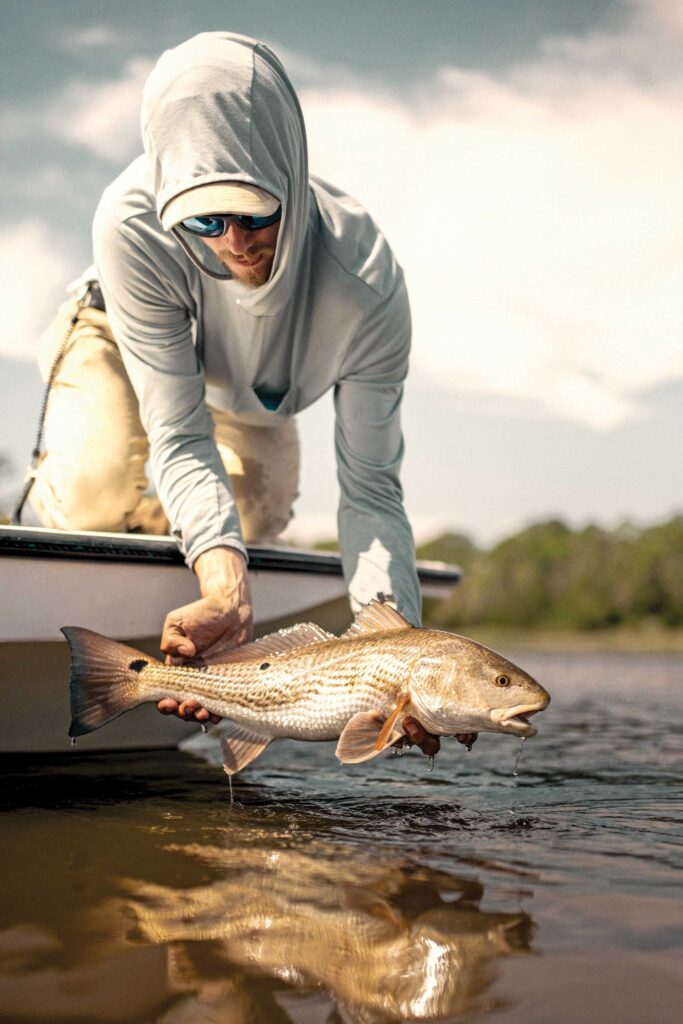
When It’s Low
While low tides minimize the fishable waters, they also concentrate reds in predictable areas. Channel edges, depressions, seawalls, and the deeper ends of docks and piers are good bets. Marsh drains consistently attract attention because water departs cleanly filtered. That tends to gather baitfish. Edges with oyster growth enhance the appeal, but the key attraction is the band of greater clarity lingering along those drain edges. Reds do this every day of their lives, so you can bet they’ll find these little food courts.
What Tempts Them
Redfish Cup Championship winners Cody Chivas and Fred Myers III did most of their work with popping-cork rigs fitted with Berkley Gulp! Shrimp on 1/8-ounce ball-head jigs. Key point: While weighted cork rigs enhance casting distance, unweighted rigs optimize stealth for the shallow marsh edges.
Rourk makes an important marsh observation: “Popping corks are only for noisy creeks with lots of mullet jumping. If the creek’s quiet, I want to fish quiet.”
Myers says he also boated solid fish on a 4-inch soft plastic rigged weedless on a 4/0, 3/16-ounce belly-weighted hook. Swimming a bait higher in the water column proved effective over oyster bars.
While most redfish anglers love their gold spoons, Hough says he’s found local fish becoming wise to this common offering. When he needs to launch a bait to spooky fish, he cuts the tail off a Berkley Gulp! Shrimp, Texas-rigs it through the back, and inserts a weight into the head.
Favoring a 4-inch Berkley Gulp! Fluke on a weighted worm hook or a Berkley Gulp! curly tail on a 1/16- to 1/8-ounce jig head, Rourk advises seasonally appropriate retrieves.
“In the winter months, move the bait inches at a time,” Rourk says. “In the summer, when fish are more active, you can increase speed and action.”

